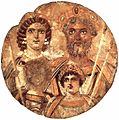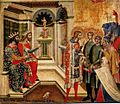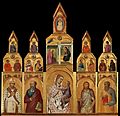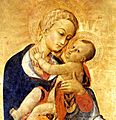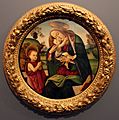Tempera facts for kids
Tempera (sometimes called egg tempera) is a special kind of paint used by artists. For a long time, it was the main type of paint used for panel painting (paintings on wooden boards) and illuminated manuscripts (decorated books). This was especially true in the Byzantine Empire and during the Middle Ages in Europe.
Later, oil painting became more popular for big artworks. But tempera is still used today, especially for Orthodox icons (religious pictures). Some modern artists also like to use tempera.
It's important to know that some companies call regular poster paint "tempera." But poster paint is actually a different kind of paint called gouache. It's not true tempera.
Contents
How Artists Paint with Tempera
Tempera paint is made using egg yolk. The yellow part of an egg dries very hard and helps the paint stick well. Artists mix dry color powders with egg yolk and water to make the paint.
In the past, some of these color powders were dangerous if breathed in. Artists had to be very careful! Usually, artists mix equal parts of egg yolk and water. If there's too much egg, the paint gets sticky. If there's too much water, it becomes too thin.
Some artists add a little egg white or even some oil for different effects. Long ago, people also added things like honey, milk, or plant gums to their tempera.
Preparing the Surface
Before painting, artists prepare a smooth, flat surface called a "ground." This ground is usually on a strong board that won't bend.
Artists apply tempera in very thin layers using tiny brush strokes. The paint dries super fast! Because tempera is a bit transparent, artists use a special method. They often paint the shadows first. Then, they paint the skin color or clothing color over the top.
Finishing a Tempera Painting
When a tempera painting is finished, its colors might not look very bright. But once it's varnished, the colors become shiny and vibrant.
A great thing about tempera paintings is how long they last. The colors don't change much over hundreds or even thousands of years. Oil paintings, however, can get darker or more yellow over time. Tempera paintings can last well for at least two thousand years!
Because tempera painting takes a lot of time, many tempera artworks are small. But some artists created large altarpieces (paintings for altars) using tempera. One of the biggest is Duccio's Madonna and Child in the Uffizi Gallery. It's about 15 feet tall! Another famous large tempera painting is Botticelli's Birth of Venus, also at the Uffizi.
History of Tempera Painting
Some of the oldest tempera paintings are funeral portraits from Ancient Rome in Egypt. These were pictures of dead people. Tempera continued to be used for Christian religious art.
It was the main medium for Greek icons. It was also widely used in Italy and other countries. This continued until oil painting became popular around the year 1500.
Many famous Italian Renaissance painters used tempera. These include Duccio, Giotto, Fra Angelico, Botticelli, and Michelangelo. In Northern Europe, artists started using oil paint earlier. Oil paint became popular in Italy in the 1570s. Leonardo even painted the Mona Lisa using oil paint.
Today, oil paint and vinyl paint are more common. But some artists still choose to paint with tempera. One famous tempera painter from the 20th century was Andrew Wyeth.
Gallery of Small Tempera Paintings
-
Byzantine icon - Christ the Judge, 5th or 6th century.
-
Illuminated manuscript - Jesus and the Gospel Writers, 9th century.
-
Proto Renaissance - Madonna and Child by the Master of St. Martin of Palma, 1300s.
-
Renaissance - Portrait of Giuliano Medici by Botticelli, 1478.
-
Illuminated manuscript - A hymn book by Niccolo da Bologna, around 1500.
Images for kids
-
Madonna and Child by Duccio, tempera and gold on wood, 1284, Siena.
-
Pietro Lorenzetti's Tarlati polyptych, tempera and gold on panel, 1320.
-
Spanish, Altar Frontal with Christ in Majesty and the Life of Saint Martin, 1250, The Walters Art Museum.
-
Duccio, Madonna and Child with saints polyptych, tempera and gold on wood, 1311–1318.
-
Bernardo Daddi, Christ Enthroned with Saints Sebastian, Leo, Alexander, Peregrine, Philip, Rufianiaus, Justa, Concordius and Decentius, 14th century.
-
Sassetta, detail of Virgin and Child with Four Saints, tempera on wood, 1435.
-
Carlo Crivelli, Madonna with Child, tempera on wood, transferred to canvas, 1470.
-
Lorenzo d'Alessandro, The Crucifixion; Saint Michael, around 1480–1490, The Walters Art Museum.
-
Sandro Botticelli, tempera on panel, 1490–1500.
-
Marianne Stokes, Melisande, tempera on canvas, 1895–1898.
See also
 In Spanish: Pintura al temple para niños
In Spanish: Pintura al temple para niños


